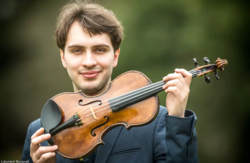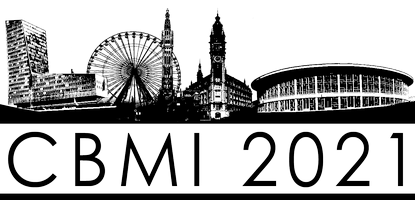June 28-30, 2021 - Lille, France
Program overview
| CET Time | Monday, June 28th | Tuesday, June 29th | Wednesday, June 30th |
| 9:00 | Welcome + Keynote: A. Del Bimbo | ||
| 9:30 | |||
| 10:00 | Break | Break | |
| 10:30 | Break | ||
| 11:00 | |||
| 11:30 | |||
| 12:00 | Lunch Break | ||
| 12:30 | Lunch Break / Best paper committee meeting | ||
| 13:00 | |||
| 13:30 | Lunch Break | ||
| 14:00 | Break | ||
| 14:30 | |||
| 15:00 | Closing | ||
| 15:30 | |||
| 16:00 | |||
| 16:30 | Steering Committee Meeting | ||
| 17:00 | |||
| 17:30 | |||
| 18:00 |
Alberto Del Bimbo, University of Firenze (Italy) — Using Memory and Attention for Compatible-garments Outfit Recommendation

Online stores have become fundamental for the fashion industry. This has motivated a lot of recent work among the scientific community to perform recommendations in the fashion domain, by harnessing the availability of large quantities of online fashion images and their rich meta-data. Combining garments appropriately is indeed not trivial as it depends on subtle compatibility rules that depend on various factors related both to the contextual factors, such as the target audience, the current fashion and its combinations of colors, shapes, and fabrics, and to individual aspects such as preferences and momentary feelings. Recent solutions have employed neural networks, aiming to learn a visual notion of compatibility across categories and a feature transformation from images of items into a latent space that expresses compatibility. In this paper, we discuss how Memory Augmented Neural Networks trained over a large corpus of outfits can provide highly effective recommendations to pair different clothing items, retrieving a ranked list of suitable bottoms to complement a given top. Differently from other solutions, we exploit separate color and shape data augmentations while training our feature extractor as an autoencoder to learn disentangled features relying only on self- supervision. Separate external memories, both for color and shape act as associative memories, relating top features with bottom features with different combination modalities for either color or shape. While providing a more extensive concept of compatibility, the solution also provides interpretable latent spaces, giving a qualitative explanation of the recommendations.
Prof. Del Bimbo is Full Professor at the Department of Information Engineering of University of Firenze. He is the author of over 350 scientific publications in computer vision, multimedia content analysis, indexing and retrieval. He was the General Chair of ICPR20290, ECCV 2012, ICMR 2011, ACM Multimedia 2010, and IEEE ICMCS 1999 and the Program Chair of ICPR 2016, and ICPR 2012, and ACM Multimedia 2008. He is the Editor in Chief of ACM TOMM Trans. on Multimedia Computing, Communications, and Applications and Associate Editor of Multimedia Tools and Applications, Pattern Analysis and Applications journals. He was Associate Editor of IEEE Trans. on Pattern Analysis and Machine Intelligence and IEEE Trans. on Multimedia. Prof. Del Bimbo is IAPR Fellow and the recipient of the 2016 ACM SIGMM Award for Outstanding Technical Contributions to Multimedia Computing, Communications and Applications.
Mohan Kankanhalli, School of Computing, National University of Singapore — Privacy-aware Analytics for Human Attributes from Images

Analyzing human attributes such as emotions, gender and age in images and videos is very important for many applications. Many existing methods perform well by utilizing human faces information. However, face images raise serious privacy concerns as they reveal people’s identity. We describe our on-going research on the problem of human attributes prediction under privacy-preserving conditions. We first did a human study of age, gender, and emotion prediction of target persons in images under various identity preserving scenarios - obfuscating eyes, lower face, head or the full face. The study used a combination of survey and eye-tracking. It revealed that in an image, the situational context is informative of a target person’s attributes. Motivated by this human study, we developed a multi-tasking deep learning model for context-guided human attributes prediction under privacy-preserving conditions and we present its results. We will end with a general discussion on privacy concerns related to image and video data analytics.
Mohan Kankanhalli is Provost's Chair Professor of Computer Science at the National University of Singapore (NUS). He is also the Dean of NUS School of Computing. Before becoming the Dean in July 2016, he was the NUS Vice Provost (Graduate Education) during 2014-2016 and Associate Provost during 2011-2013. Mohan obtained his BTech from IIT Kharagpur and MS & PhD from the Rensselaer Polytechnic Institute. Mohan’s research interests are in Multimedia Computing, Information Security and Privacy, Image/Video Processing and Social Media Analysis. He directs N-CRiPT (NUS Centre for Research in Privacy Technologies) which conducts research on privacy on structured as well as unstructured (multimedia, sensors, IoT) data. N-CRiPT looks at privacy at both individual and organizational levels along the entire data life cycle. He is personally involved in privacy research related to images, video and social media as well as privacy risk management. N-CRiPT, which has been funded by Singapore’s National Research Foundation, works with many industry, government and academic partners.
Cécile Favre, University Lyon 2 (France) — Diversity and Women in Multimedia Research

Computer science is a gendered discipline. Ensuring gender diversity among researchers has been the subject of various initiatives with more or less efficiency in different countries. In this context, this presentation has two main objectives. First, this talk aims to explain some aspects of this gender dimension in computer science by specifying the challenges of this gender diversity within researchers. Second, based on some thematic covered by the CBMI conference, diversity issues will be put into perspective, by discussing the posture of researchers in computer science.
Cécile Favre is Associate Professor in Computer Science at the University Lyon 2, in France.
She is a member of the ERIC lab (lab of computer science) and she is an associate researcher in the Centre Max Weber (lab of sociology). Her position in the Faculty of Anthropology, Sociology and Political Science led her to accentuate her openness to interdisciplinarity with the humanities and social sciences.
She has been involved in the teaching team of the Master's program in Gender Studies since its creation in Lyon in 2011. She is now involved in various responsibilities in the Mention of Master in Gender Studies in the University Lyon 2 that concern mare than 200 students every year. Indeed, she is in charge of the development of continuing education for adults in the gender studies domain. Moreover, she is in charge of the EGALES international master's network.
Her research interests in computer science include social media analysis, business intelligence. She also conducts research integrating the gender dimension. She has notably worked on the issue of quotas as an equality policy in higher education and research.
Oral and special sessions
Best Paper Session
- Paper #6: Towards a content-based prediction of personalizedmusical preferences using transfer learning. Nicolas Dauban, Christine Sénac, Julien Pinquier and Pascal Gaillard.
- Paper #18: Gesture of Interest: Gesture Search for Multi-Person, Multi-Perspective TV Footage. Mahnaz Parian-Scherb, Claire Walzer, Luca Rossetto, Silvan Heller, Stéphane Dupont and Heiko Schuldt.
- Paper #38: Towards a Privacy Respecting Image-based User Profiling Component. Panagiotis Galopoulos, Chryssanthi Iakovidou, Vasiliki Gkatziaki, Symeon Papadopoulos and Yiannis Kompatsiaris.
- Paper #30: The Influence of Audio on Video Memorability with an Audio Gestalt Regulated Video Memorability System. Lorin Sweeney, Graham Healy and Alan Smeaton.
Oral Session 1: Learning
- Paper #12: Eye-Gaze Estimation using a Capsule-based Regression Network. Vivien Bernard, Hazem Wannous and Jean-Philippe Vandeborre.
- Paper #31: Towards Efficient Cross-Modal Visual Textual Retrieval using Transformer-Encoder Deep Features. Nicola Messina, Giuseppe Amato, Fabrizio Falchi, Stephane Marchand-Maillet and Claudio Gennaro.
- Paper #41: Learning Vocabularies to Embed Graphs in Multimodal Rank Aggregation Tasks. Icaro Dourado and Ricardo Torres.
- Paper #62: Correlated Adversarial Joint Discrepancy Adaptation Network. Youshan Zhang and Brian Davison.
Oral Session 2: Multimodal Content
- Paper #19: A GRU Neural Network with attention mechanism for detection of risk situations on multimodal lifelog data. Rupayan Mallick, Thinhinane Yebda, Jenny Benois-Pineau, Akka Zemmari, Marion Pech and Hélène Amieva.
- Paper #44: BAREM: A multimodal dataset of individuals interacting with an e-service platform. Romain Belmonte, Amel Aissaoui, Sofiane Mihoubi, Benjamin Allaert, José Mennesson, Ioan Marius Bilasco and Laurent Goncalves.
- Paper #59: Investigating Automated Mechanisms for Multi-Modal Prediction of User Online-Video Commenting Behaviour. Hao Wu, Francois Pitie and Gareth Jones.
- Paper #52: Novel programmable single pulse generator for producing pulse widths in different time scales. Hamidreza Erfanijazi, Teresa Serrano-Gotarredona and Bernabe Linares-Barranco.
Oral Session 3: Sematic Regions and Events
- Paper #21: Content-based image retrieval: Colorfulness and Depth visual perception quantification. Solène Vilfroy, Thierry Urruty, Phillipe Carré, Lionel Bombrun and Arnaud Bour.
- Paper #34: Operation-wise Attention Network for Tampering Localization Fusion. Polychronis Charitidis, Giorgos Kordopatis-Zilos, Symeon Papadopoulos and Ioannis Kompatsiaris.
- Paper #47: Table Tennis ball kinematic parameters estimation from ecological single-view videos. Jordan Calandre, Renaud Péteri, Laurent Mascarilla and Benoit Tremblais.
- Paper #49: Evaluation of Object Detection Systems and Video Tracking in Skiing Videos. Philip Steinkellner and Klaus Schoeffmann.
Special Session: Remote Sensing
- Paper #42: Mining atmospheric data. Chaabane Djeraba and Jérôme Riedi.
- Paper #65: Compression of Solar Spectroscopic Observations: Case Study of Mg II k Spectral Line Profiles Observed by NASA's IRIS Satellite. Viacheslav Sadykov, Irina Kitiashvili, Alberto Sainz Dalda, Vincent Oria, Alexander Kosovichev and Egor Illarionov.
Special Session: BICSAM
- Paper #20: A Study on the Effects of Pre-processing On Spatio-temporal Action Recognition Using Spiking Neural Networks Trained with STDP. Mireille Elassal, Pierre Tirilly and Ioan Marius Bilasco.
- Paper #32: Bio-inspired visual attention for silicon retinas based on spiking neural networks applied to pattern classification. Amélie Gruel and Jean Martinet.
- Paper #40: Deep Spiking Convolutional Neural Network for Single Object Localization Based On Deep Continuous Local Learning. Sami Barchid, José Mennesson and Chaabane Djéraba.
- Paper #43: A robust bio-inspired approach to event-driven object recognition. Antoine Grimaldi, Victor Boutin, Laurent Perrinet, Sio Hoi Ieng and Ryad Benosman.
- Paper #50: Sub-0.3V CMOS neuromorphic technology and its potential application. Francois Danneville, Kevin Carpentier, Ilias Sourikopoulos, Michel Paindavoine and Christophe Loyez.
- Paper #61: VS2N: Interactive Dynamic Visualization and Analysis Tool for Spiking Neural Networks. Hammouda Elbez, Mohammed Kamel Benhaoua, Philippe Devienne and Pierre Boulet.
Special Session: COBLA
- Paper #10: Detecting the early inspiral of a gravitational-wave signal with convolutional neural networks. Grégory Baltus, Justin Janquart, Melissa Lopez, Amit Reza, Jean-René Cudell and Sarah Caudill.
- Paper #14: Deep learning algorithms for gravitational waves core-collapse supernova detection. Melissa Lopez, Irene Di Palma, Marco Drago, Pablo Carda-Duran and Fulvio Ricci.
- Paper #23: First Full-Event Reconstruction from Imaging Atmospheric Cherenkov Telescope Real Data with Deep Learning. Mikaël Jacquemont, Thomas Vuillaume, Alexandre Benoit, Gilles Maurin, Patrick Lambert and Giovanni Lamanna.
- Paper #46: Gravitational-wave parameter inference using Deep Learning. Osvaldo G. Freitas, António Onofre, José A. Font, António P. Morais, Felipe F. Freitas, Alejandro Torres-Forné, Solange Nunes and João D. Álvares.
- Paper #57: Deep learning searches for gravitational waves stochastic backgrounds. Andrei Utina, Filip Morawski and Alberto Iess.
- Paper #60: Galaxy Morphology in the deep learning era. Marc Huertas-Company.
Poster and demo session
Posters
- Paper #2: Automatic macro segmentation into interaction sequence: a silence-based approach for meeting structuring. Lionel Pibre, Sélim Mechrouh, Thomas Pellegrini, Julien Pinquier and Isabelle Ferrané.
- Paper #9: Real-time detection of partial video copy on TV workstation. Van-Hao Le, Mathieu Delalandre and Donatello Conte.
- Paper #22: Loss Function Approaches for Multi-label Music Tagging. Dillon Knox, Timothy Greer, Benjamin Ma, Emily Kuo, Krishna Somandepalli and Shrikanth Narayanan.
- Paper #27: A User-Centered Approach for Recognizing Convenience Images in Personal Photo Collections. Matthias Maszuhn, Larbi Abdenebaoui and Susanne Boll-Westermann.
- Paper #29: Review on Indoor RGB-D Semantic Segmentation with Deep Convolutional Neural Networks. Sami Barchid, José Mennesson and Chaabane Djeraba.
- Paper #35: Human Action Recognition Based on Body Segmentation Models. Catherine Huyghe, Nacim Ihaddadene, Thomas Haessle and Chabane Djeraba.
- Paper #51: Multimodal Detection of Information Disorder from Social Media. Armin Kirchknopf, Djordje Slijepcevic and Matthias Zeppelzauer.
- Paper #56: A multi-angle shape descriptor with the distance ratio to vertical bounding rectangles. Zekun Li, Baolong Guo and Fangliang He.
Demos
- Paper #4: The Diabetic Buddy: A Diet Regulator and Tracking System for Diabetics. Muhammad Usman, Kashif Ahmad, Amir Sohail and Marwa Qaraqe.
- Paper #8: Automatic Analysis of Amateur Film and Video Collections. Georg Thallinger and Werner Bailer.
- Paper #39: Post-surgical Endometriosis Segmentation in Laparoscopic Videos. Andreas Leibetseder, Klaus Schoeffmann, Jörg Keckstein and Simon Keckstein.
- Paper #48: A Computational Tool to Study Vocal Participation of Women in UN-ITU Meetings. Rajat Hebbar, Krishna Somandepalli, Raghuveer Peri, Ruchir Travadi, Tracy Tuplin, Fernando Rivera and Shrikanth Narayanan.
- Paper #54: Crowd Violence Detection from Video Footage. Konstantinos Gkountakos, Konstantinos Ioannidis, Theodora Tsikrika, Stefanos Vrochidis and Ioannis Kompatsiaris.
Social Event

Concert by François Pineau-Benois
website: https://en.francoispineaubenois.com/

